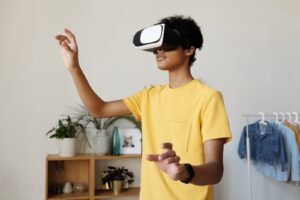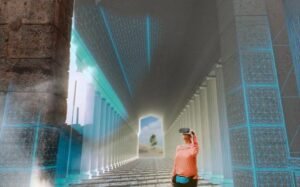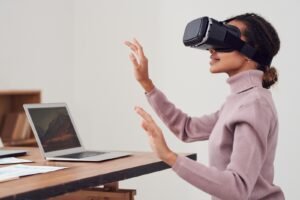Looking for the latest VR educational experiences? Augment Explorer, is an innovative education VR company, which offers interactive and immersive learning experiences.
Virtual and augmented reality is transforming education and opening up new opportunities that traditional teaching techniques cannot match thanks to immersive experiences and interactive simulations. This article, brought to you by Augment Explorer will examine the advantages and uses of virtual reality (VR) in education in this article, as well as how this ground-breaking technology is changing how students learn.
One of VR’s major educational benefits is its capacity to move pupils to many environments, eliminating logistical and geographical restrictions. Virtual reality (VR) gives students the opportunity to interact with content in a way that goes beyond textbooks and lectures, whether it is by investigating ancient civilisations, dissecting digital organisms, or carrying out challenging experiments. Virtual reality (VR) aids in better information retention by giving users a sense of presence and involvement.
Virtual reality has a wide range of educational uses, from K–12 classrooms to corporate training programmes. In addition to accommodating various learning styles, virtual reality (VR) can promote teamwork, critical thinking, and problem-solving abilities. Additionally, it provides a secure and controlled atmosphere where students can make mistakes and learn from them without worrying about the repercussions in the real world.
Join us as we investigate how VR is transforming the future of learning and explore the potential of this technology in education.
What does educational VR entail?
The use of VR technology to provide immersive and interactive learning experiences is referred to as virtual reality in education. Virtual reality (VR) enables students to interact with instructional content in a more meaningful and immersive way by imitating real-world surroundings and circumstances. Students can access a virtual world that feels genuine through the use of headsets, giving them a sense of presence and engagement that traditional teaching techniques lack.
Virtual reality’s advantages in education
One of VR’s major educational benefits is its capacity to move pupils to many environments, eliminating logistical and geographical restrictions. Virtual reality (VR) gives students the opportunity to interact with content in a way that goes beyond textbooks and lectures, whether it is by investigating ancient civilisations, dissecting digital organisms, or carrying out challenging experiments. Virtual reality (VR) aids in better information retention by giving users a sense of presence and involvement.
Additionally, using VR in education provides a secure, controlled environment that allows students to make mistakes and grow from them without facing any negative consequences in the real world. For instance, at medical school, virtual reality simulations let students practise procedures and surgeries without endangering real patients. Before they enter a genuine healthcare environment, this not only improves their abilities but also increases their confidence.
VR in education can also accommodate various learning preferences. While auditory learners can participate in the interactive audio elements, visual learners can profit from the immersive and visually exciting experiences. The hands-on element of VR, which allows users to manipulate items and engage with the virtual environment, can also be advantageous for kinaesthetic learners.
Statistics on virtual reality in the classroom
Numerous statistics and research have been done that demonstrate the effect of VR on education. The global market for VR in education is anticipated to expand at a compound annual growth rate (CAGR) of more than 59% between 2020 and 2024, according to a Technavio analysis. The study also shows that, when compared to conventional learning methods, VR can increase knowledge retention by as much as 80%.
According to a University of Maryland research, pupils who learnt using virtual reality had a greater grasp of the subject matter and performed better on examinations than those who learned using conventional techniques. The study also found that adopting VR as a learning tool increased students’ motivation and engagement.
Virtual reality education applications
Virtual reality has a wide range of educational uses, from K–12 classrooms to corporate training programmes. Virtual reality (VR) can be utilised in K–12 classrooms to take kids on virtual field trips so they can experience historical monuments, natural wonders, and cultural landmarks without ever leaving the building. In addition to making learning more immersive, this also makes material more interesting and memorable.
Additionally, complex scientific ideas like physics and anatomy can be taught through virtual reality (VR). Three-dimensional models allow students to manipulate and visualise concepts, which makes it simpler for them to comprehend complex ideas. For instance, in biology studies, students might investigate the human body’s various systems and organs to obtain a deeper knowledge of how they function.
VR integration can be very helpful in both business settings and vocational training. To practise skills and circumstances relevant to their professional tasks, employees can use VR to recreate realistic work environments. This can be especially helpful in fields where practical experience is essential, such as manufacturing, aviation, and healthcare.
Virtual reality education in the classroom
Planning and thought must go into incorporating VR in the classroom. All pupils must be able to access the technology, and it must also be in line with the curriculum, according to teachers. In order to successfully include VR into their teaching practises, they should also obtain the appropriate training.
In order to give students a smooth VR experience, schools must also spend money on the appropriate hardware, such as VR headsets and interactive controllers. Additionally, collaborative VR platforms can be used, enabling students to collaborate on projects and tasks while interacting with one other in the virtual world.
It’s crucial to remember that VR should not completely replace conventional teaching methods, but rather enhance them. Virtual reality can be utilised as an additional tool to improve learning and include students more fully.
VR in education: Challenges and Considerations
While there is no denying the advantages of VR in education, there are also issues and problems that must be considered. The expense of integrating VR technology in classrooms is one of the major obstacles. Due to the high cost of VR equipment, software, and maintenance, some educational institutions find it challenging to implement this technology.
The possible health impacts of VR, such as motion sickness and eye strain, are another thing to think about. To avoid any negative impacts, schools must make sure that pupils take regular breaks and use VR sparingly. To make sure they are suitable for children and support educational goals, VR experiences and material need to be carefully selected.
Concerns about privacy and safety are also crucial factors. Protecting student data should be a top priority for VR platforms and applications, and data privacy laws must be followed. Additionally, standards and practises for responsible VR use, including acceptable conduct and ethical issues, should be established in schools.
Virtual reality education and training
The need for VR training courses and programmes in education is growing. To assist educators in incorporating VR into their teaching practises, many educational institutions and organisations provide training and certifications. These courses address subjects like VR technology and software, content development, and efficient pedagogical methods for using VR.
For educators and students who wish to learn more about VR and its uses in education, there are online courses and tutorials accessible. These programmes give students a thorough understanding of VR technology and its potential effects on education.
Services and products for VR in education
Numerous businesses and service providers provide specialised solutions to educational institutions in response to the rising demand for VR in education. These services can include everything from VR content creation and curation to technical assistance and equipment upkeep. Some businesses also provide VR lab setups and classroom integration services, making sure that schools have the facilities and tools needed to use VR successfully.
School-specific requirements are met by educational VR systems, which offer a seamless VR experience for both teachers and students. To enable a seamless incorporation of VR into the educational setting, these systems frequently incorporate content libraries, collaboration tools, and technical support.
Conclusion
The use of virtual reality in education has the power to change how students comprehend and interact with course material. VR can help students retain more information, accommodate various learning styles, and develop their critical thinking and problem-solving abilities by offering immersive and engaging experiences. The uses of virtual reality in education are numerous and diverse, ranging from interactive simulations to virtual field excursions.
Although there are issues and concerns to consider, the advantages of VR in education outweigh the drawbacks. With VR technology’s continuing development and the expansion of VR platforms and tools, educators now have the chance to fully use VR and reimagine the future of education. Educational institutions can improve the learning environment for students of all ages by integrating virtual reality (VR).
We hope you found this article about applying VR in education beneficial. If you would like to keep up to date with the latest news and trends about immersive learning and classroom VR experiences, please visit our news and articles page.






